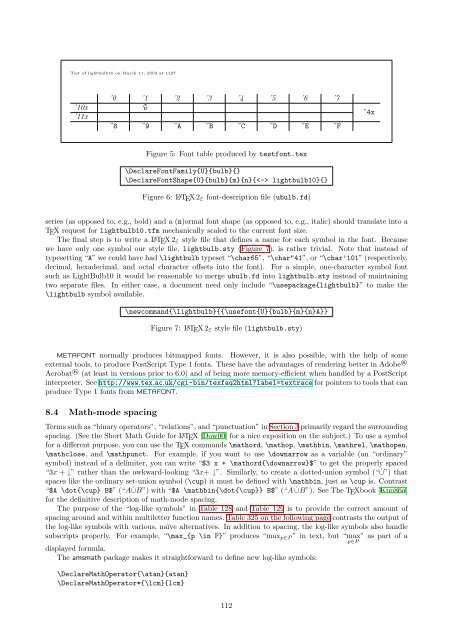symbols-a4
symbols-a4
symbols-a4
You also want an ePaper? Increase the reach of your titles
YUMPU automatically turns print PDFs into web optimized ePapers that Google loves.
Test of lightbulb10 on March 11, 2003 at 1127<br />
´0 ´1 ´2 ´3 ´4 ´5 ´6 ´7<br />
´10x<br />
´11x<br />
<br />
˝8 ˝9 ˝A ˝B ˝C ˝D ˝E ˝F<br />
Figure 5: Font table produced by testfont.tex<br />
\DeclareFontFamily{U}{bulb}{}<br />
\DeclareFontShape{U}{bulb}{m}{n}{ lightbulb10}{}<br />
Figure 6: L ATEX 2ε font-description file (ubulb.fd)<br />
series (as opposed to, e.g., bold) and a (n)ormal font shape (as opposed to, e.g., italic) should translate into a<br />
TEX request for lightbulb10.tfm mechanically scaled to the current font size.<br />
The final step is to write a L ATEX 2ε style file that defines a name for each symbol in the font. Because<br />
we have only one symbol our style file, lightbulb.sty (Figure 7), is rather trivial. Note that instead of<br />
typesetting “A” we could have had \lightbulb typeset “\char65”, “\char"41”, or “\char’101” (respectively,<br />
decimal, hexadecimal, and octal character offsets into the font). For a simple, one-character symbol font<br />
such as LightBulb10 it would be reasonable to merge ubulb.fd into lightbulb.sty instead of maintaining<br />
two separate files. In either case, a document need only include “\usepackage{lightbulb}” to make the<br />
\lightbulb symbol available.<br />
\newcommand{\lightbulb}{{\usefont{U}{bulb}{m}{n}A}}<br />
Figure 7: L ATEX 2ε style file (lightbulb.sty)<br />
METAFONT normally produces bitmapped fonts. However, it is also possible, with the help of some<br />
external tools, to produce PostScript Type 1 fonts. These have the advantages of rendering better in Adobe ®<br />
Acrobat ® (at least in versions prior to 6.0) and of being more memory-efficient when handled by a PostScript<br />
interpreter. See http://www.tex.ac.uk/cgi-bin/texfaq2html?label=textrace for pointers to tools that can<br />
produce Type 1 fonts from METAFONT.<br />
8.4 Math-mode spacing<br />
Terms such as “binary operators”, “relations”, and “punctuation” in Section 3 primarily regard the surrounding<br />
spacing. (See the Short Math Guide for LATEX [Dow00] for a nice exposition on the subject.) To use a symbol<br />
for a different purpose, you can use the TEX commands \mathord, \mathop, \mathbin, \mathrel, \mathopen,<br />
\mathclose, and \mathpunct. For example, if you want to use \downarrow as a variable (an “ordinary”<br />
symbol) instead of a delimiter, you can write “$3 x + \mathord{\downarrow}$” to get the properly spaced<br />
“3x + ↓” rather than the awkward-looking “3x+ ↓”. Similarly, to create a dotted-union symbol (“ ˙∪”) that<br />
spaces like the ordinary set-union symbol (\cup) it must be defined with \mathbin, just as \cup is. Contrast<br />
“$A \dot{\cup} B$” (“A ˙∪B”) with “$A \mathbin{\dot{\cup}} B$” (“A ˙∪B”). See The TEXbook [Knu86a]<br />
for the definitive description of math-mode spacing.<br />
The purpose of the “log-like <strong>symbols</strong>” in Table 128 and Table 129 is to provide the correct amount of<br />
spacing around and within multiletter function names. Table 325 on the following page contrasts the output of<br />
the log-like <strong>symbols</strong> with various, naïve alternatives. In addition to spacing, the log-like <strong>symbols</strong> also handle<br />
subscripts properly. For example, “\max_{p \in P}” produces “maxp∈P ” in text, but “max”<br />
as part of a<br />
p∈P<br />
displayed formula.<br />
The amsmath package makes it straightforward to define new log-like <strong>symbols</strong>:<br />
\DeclareMathOperator{\atan}{atan}<br />
\DeclareMathOperator*{\lcm}{lcm}<br />
112<br />
˝4x


